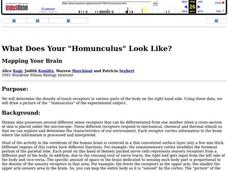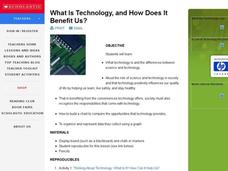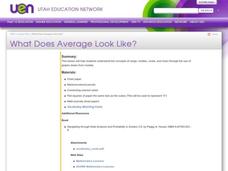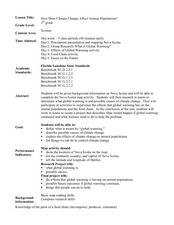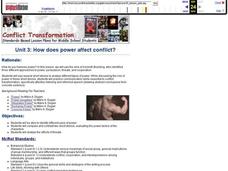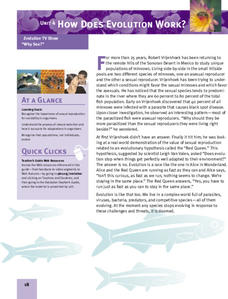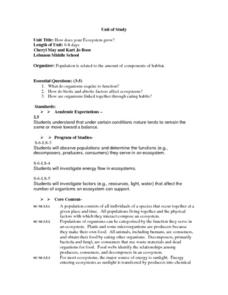Curated OER
What Does Your "Homunculus" Look Like?
Students investigate the density of touch receptors in various parts of the body. They discover how the body senses various stimuli, then maps a picture of the "homunculus" of the experimental subject.
Curated OER
What Is Technology, and How Does It Benefit Us?
Students examine and define what technology is as well as the differences between science and technology. They assess the role of science and technology in society, conveniences technology offers and create a chart to compare the...
Curated OER
What Does Average Look Like?
Fifth graders explore the concepts of range, median, mode, and mean through the use of graphs drawn from models. They use manipulatives to represent data they have collected within their groups, and compare the differences between mode,...
Curated OER
What Does It Need?
For this identifying needs worksheet, students observe picture words and fill in the correct boxes indicating their needs of water, air, and food. Students determine the needs for seven items.
Curated OER
How Does Your Garden Grow?
Students construct and maintain a school garden. In this gardening instructional activity, students plan the construction of the garden by writing letters to local businesses asking for supplies and materials; students build the garden...
Curated OER
How Does the Angle Effect How Fast a Car Will Travel?
For this angle of movement and speed worksheet, students determine at which angle a car will travel the fastest. They test 12 different angles on a toy car and determine from their data which angle is the best for speed.
Curated OER
What Does Ginny Have?
In this grammar instructional activity, students read a short paragraph and then fill in 14 blanks within the paragraph with the correct form of the verbs have or has.
Curated OER
The Vitruvian Theory - Does It Apply to You?
Students explore the concept of the Vitruvian theory. In this Vitruvian theory instructional activity, students collect data from their classmates about their arm span and height. Students compare their ratios of arm...
Curated OER
How does Paper Making Contribute to Economics
Second graders investigate the numerous jobs it takes to create paper in the U.S. In this economics lesson, 2nd graders discuss where paper comes from, what types of trees are needed, and how the paper milling process creates jobs...
Curated OER
Seeds! What is Inside; How does it Grow and Why is it Important?
Students discover the importance of seeds in relationship to nature. In this plant growth lesson plan, students create a collection of seeds and discover the best type of environment to plant them. Students plant their own...
Curated OER
How Does Climate Change Affect Animal Populations?
Students investigate the effect of climate change on animal population in Nova Scotia. In this environmental science lesson, students complete a Nova Scotia map activity and research the causes of global warming in small groups. Students...
Curated OER
How Does Power Affect Conflict?
Students use several short stories to analyze different types of power. While discussing the role of power in these short stories, students will practice communication skills essential to conflict transformation, specifically attentive...
Curated OER
Where does our trash come from?
Students interview the school custodian to get information about the trash found in the school community. In this trash lesson, students work in groups to analyze the content of a waste basket, see where the trash goes and...
Curated OER
Investigation - What Does 1,000 Look Like?
Second graders determine what 1,000 items look like. In this math investigation instructional activity, 2nd graders collect 1,000 items and determine the best way to count them by tens and hundreds. They can use stickers on notecards to...
Curated OER
Conservation at a Crossroads Lesson 1: What Is Conservation and Why Does It Matter?
Students explore the concept of conservation. In this conservation lesson, students read articles and primary documents about the Conservation Movement in the United States and compare the movement to today's environmental movements....
Curated OER
How Many Hats Does a Farmer Wear
In this farmer worksheet, learners make a spinning wheel to describe the jobs of a farmer. Students create 1 wheel with 8 different jobs for a farmer.
Curated OER
Does Dye Die? Foreign Chemicals in Our Environment
Students conduct an experiment to observe photolysis in the lab. In this chemistry instructional activity, students explain the mechanism behind photolysis. They test the impact of a non-toxic marker to plant metabolism.
Curated OER
Does Global Warming Increase the Intensity of Atmospheric Natural Disasters?
Students study global warming by communicating the problem, process and solutions. In this global lesson plan students use graphs, research and write a critical stance on natural disasters.
Curated OER
After the Garbage Can: Where Does Our Trash Go?
Students explore how waste disposal has changed over time and what the current issues are. In this disposal instructional activity students collect data and create graphs.
Curated OER
How Does Evolution Work?
Students are introduced to how the process of evolution works. As a class, they review the characteristics of natural selection and how those with advantageous traits reproduce and survive. To test this theory of natural selection,...
Curated OER
What Does Dna Look Like?
Students build DNA strands and practice base pairing rules using an interactive website in this technology-based lesson for a high school science class. This lesson includes links to the interactive website, a worksheet, and a video...
Curated OER
How Does Your Ecosystem Grow?
Students consider that under certain conditions in nature tend to remain the same or move toward a balance. They observe populations and determine the functions (e.g., de-composers, producers, consumers) they serve in an ecosystem. They...
Curated OER
"Juanita Does the Laundry"
In this reading comprehension worksheet, students read a short story that describes a woman doing her laundry in a laundromat. Students then answer 10 multiple choice questions.
Curated OER
How Fast Does the Sun Spin?
In this rotation of celestial bodies worksheet, students determine the speed of the sun's rotation and they determine the number of days it takes the sun to rotate once at the equator. They identify the geometric factor that causes...
Other popular searches
- Picture Does Not Belong
- Life Doesn't Frighten Me
- Al Capone Does My Shirts
- Do and Does
- Sentence Doesn't Belong
- Which Word Does Not Belong
- Beatrice Doesn't Want To
- Does Not Belong
- How Does Light Travel
- Sentence Does Not Belong
- Which Does Not Belong
- Anansi Does the Impossible
